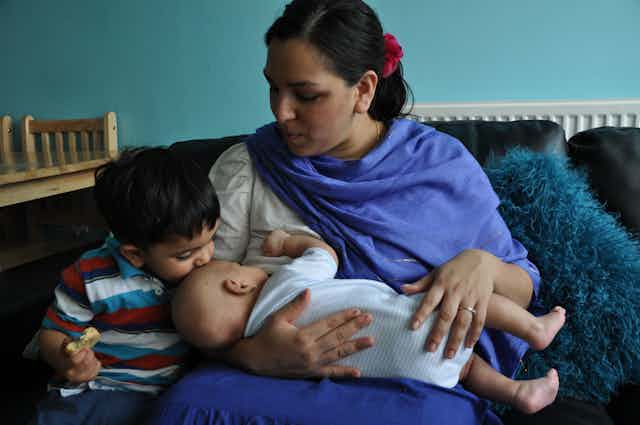Human breast milk is perfectly constituted for human babies. Not only does it provide balanced nutrition tailored to each baby’s needs, it also strengthens the immune system through a combination of ingredients including antibodies, hormones, vitamins and carbohydrates. Yet breastfeeding rates are low. Worldwide, just 37% of babies under six-months-old are exclusively breastfed. Rates are lowest in wealthy countries, and lowest of all in the deprived communities in those countries.
We wanted to know if incentives could improve breastfeeding rates in areas of the UK with low breastfeeding rates. Our latest study, published in JAMA Pediatrics, found that financial incentives – in the form of shopping vouchers – improved breastfeeding rates at six to eight weeks after birth by six percentage points in areas with low breastfeeding rates.
Our trial, jointly run by the University of Sheffield and the University of Dundee, was carried out between February 2015 and February 2016 in 92 areas (electoral wards) with low breastfeeding rates in South Yorkshire, Derbyshire and North Nottinghamshire.
We randomly selected 46 areas in which to offer the voucher scheme (5,398 women). The women were told about the scheme by their midwives, health visitors, nurses and doctors. The women in the remaining 46 areas, who were not offered vouchers, acted as the controls in the study (4,612 women).
Mothers could claim the vouchers, each worth £40, on five occasions, based on their baby’s age: two days, ten days, six weeks, three months and six months. Vouchers were given if the baby received any breast milk every day, even if the baby was also receiving formula or other fluids or food.

Midwives and health visitors asked the mothers how the baby was being fed during their routine visits. They recorded whether the baby was exclusively breastfed, only fed with processed food (infant formula), or given a combination of breast milk and infant formula. And although this is not a foolproof way of knowing whether mothers’ breastfed their baby or not, it was the best option. Any other approach might signal to women that their healthcare providers didn’t trust them.
Those areas randomly selected to have the voucher scheme had significantly higher breastfeeding rates at six to eight weeks than similar areas without the scheme (38% vs 32%). This was the primary outcome of the study and the one we were most interested in, because the time when women are more likely to stop breastfeeding is in these early weeks. Other outcomes – exclusive breastfeeding and breastfeeding at other time points – were not significantly different.
No other intervention in the UK has shown such a large effect in areas with low breastfeeding rates.
These findings can now inform a debate with those who make public health policy decisions in the UK. This debate should use evidence from other studies to inform, for example, questions of cost effectiveness and whether or not the scheme should be rolled out to other areas.
Cost savings
Previous research has shown that in the NHS could save about £17m a year if breastfeeding rates were increased. This is based on cost savings from a reduction in acute, short-term diseases in babies, including gastrointestinal and respiratory infections.
There is increasing evidence from epidemiological studies and a large trial that there may also be benefits in the longer term, resulting from reductions in diseases, such as type 2 diabetes, obesity and cancer, as well as improvements in intelligence and educational achievement.
More work will be needed to examine the cost effectiveness of this intervention. Cost effectiveness will probably depend on how the scheme is deployed – whether it is offered to all new mothers or just to those living in areas where the breastfeeding rates are low. Although calculating the true cost of disease and developmental deficits resulting from not breastfeeding is complex and not always possible using existing data.
Our findings will hopefully help to inform and guide efforts to shift the significant barriers to breastfeeding. Such a shift would improve health and well-being of babies and mothers in the most deprived communities. We believe this approach offers real hope and a strong foundation for future work.

